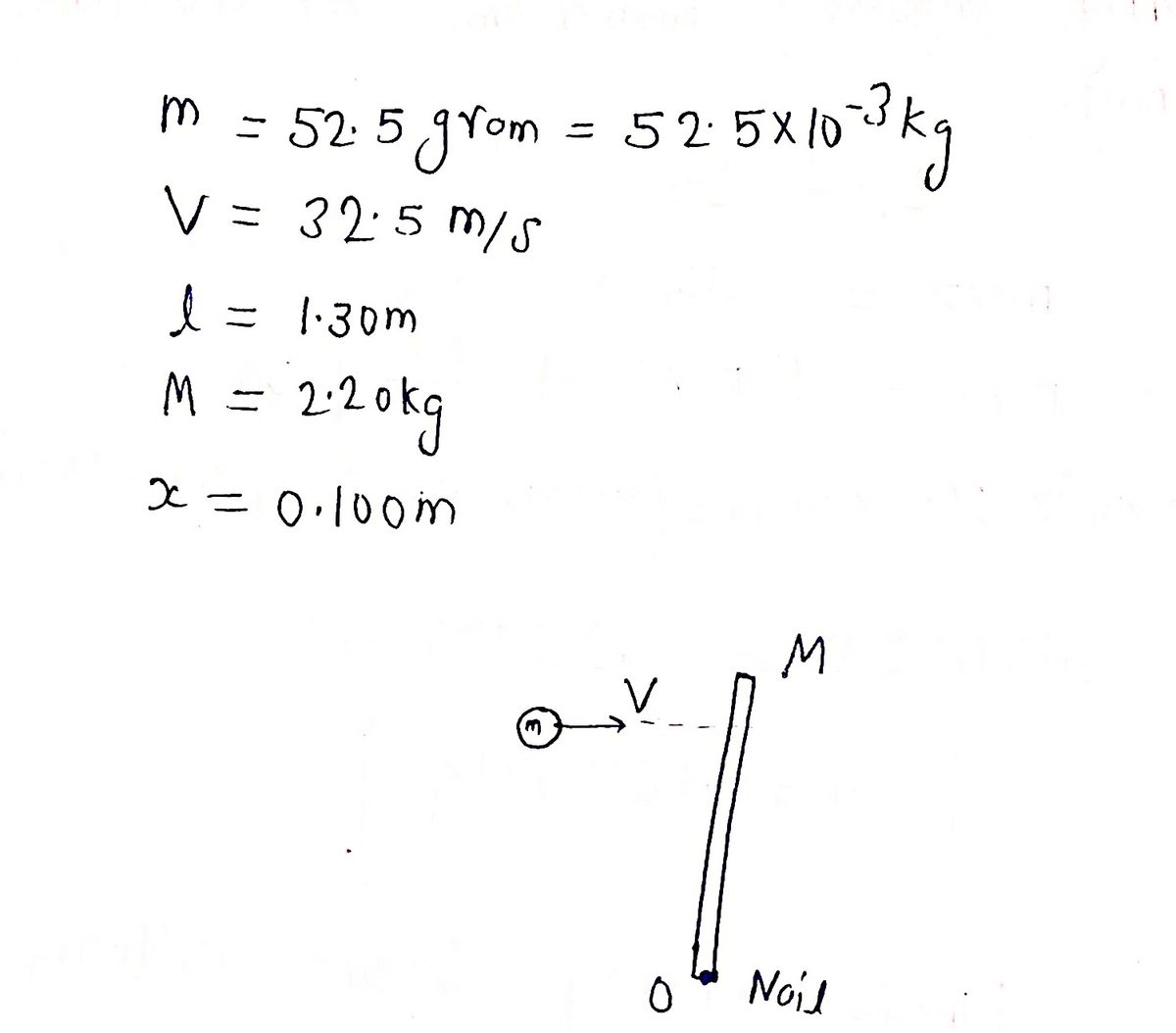A disk slides toward a motionless stick on a frictionless surface (figure below). The disk strikes and adheres to the stick and they rotate together, pivoting around the nail. Angular momentum is conserved for this inelastic collision because the surface is frictionless and the unbalanced external force at the nail exerts no torque. = Before mv = (b) What is the kinetic energy (in J) before and after the collision? J K before Kafter = M Nail (pivot) (a) Consider a situation where the disk has a mass of 52.5 g and an initial velocity of 32.5 m/s when it strikes the stick that is 1.30 m long and 2.20 kg at a distance of 0.100 m from the nail. (a) What is the angular velocity (in rad/s) of the two after the collision? (Enter the magnitude.) X rad/s 1 After m 2 (0) (c) What is the total linear momentum (in kg m/s) before and after the collision? (Enter the magnitude.) Pbefore kg. m/s Pafter kg. m/s
A disk slides toward a motionless stick on a frictionless surface (figure below). The disk strikes and adheres to the stick and they rotate together, pivoting around the nail. Angular momentum is conserved for this inelastic collision because the surface is frictionless and the unbalanced external force at the nail exerts no torque. = Before mv = (b) What is the kinetic energy (in J) before and after the collision? J K before Kafter = M Nail (pivot) (a) Consider a situation where the disk has a mass of 52.5 g and an initial velocity of 32.5 m/s when it strikes the stick that is 1.30 m long and 2.20 kg at a distance of 0.100 m from the nail. (a) What is the angular velocity (in rad/s) of the two after the collision? (Enter the magnitude.) X rad/s 1 After m 2 (0) (c) What is the total linear momentum (in kg m/s) before and after the collision? (Enter the magnitude.) Pbefore kg. m/s Pafter kg. m/s
College Physics
11th Edition
ISBN:9781305952300
Author:Raymond A. Serway, Chris Vuille
Publisher:Raymond A. Serway, Chris Vuille
Chapter1: Units, Trigonometry. And Vectors
Section: Chapter Questions
Problem 1CQ: Estimate the order of magnitude of the length, in meters, of each of the following; (a) a mouse, (b)...
Related questions
Question
100%

Transcribed Image Text:A disk slides toward a motionless stick on a frictionless surface (figure below). The disk strikes and adheres to the stick and they rotate
together, pivoting around the nail. Angular momentum is conserved for this inelastic collision because the surface is frictionless and the
unbalanced external force at the nail exerts no torque.
Before
M
Nail (pivot)
(b) What is the kinetic energy (in J) before and after the collision?
J
K before
K
J
after
(b)
Consider a situation where the disk has a mass of 52.5 g and an initial velocity of 32.5 m/s when it strikes the stick that is 1.30 m long
and 2.20 kg at a distance of 0.100 m from the nail.
(a) What is the angular velocity (in rad/s) of the two after the collision? (Enter the magnitude.)
X rad/s
=
After
(0)
(c) What is the total linear momentum (in kg · m/s) before and after the collision? (Enter the magnitude.)
kg. m/s
Pbefore
kg. m/s
Pafter
Expert Solution
Step 1

Step by step
Solved in 4 steps with 4 images

Knowledge Booster
Learn more about
Need a deep-dive on the concept behind this application? Look no further. Learn more about this topic, physics and related others by exploring similar questions and additional content below.Recommended textbooks for you

College Physics
Physics
ISBN:
9781305952300
Author:
Raymond A. Serway, Chris Vuille
Publisher:
Cengage Learning

University Physics (14th Edition)
Physics
ISBN:
9780133969290
Author:
Hugh D. Young, Roger A. Freedman
Publisher:
PEARSON

Introduction To Quantum Mechanics
Physics
ISBN:
9781107189638
Author:
Griffiths, David J., Schroeter, Darrell F.
Publisher:
Cambridge University Press

College Physics
Physics
ISBN:
9781305952300
Author:
Raymond A. Serway, Chris Vuille
Publisher:
Cengage Learning

University Physics (14th Edition)
Physics
ISBN:
9780133969290
Author:
Hugh D. Young, Roger A. Freedman
Publisher:
PEARSON

Introduction To Quantum Mechanics
Physics
ISBN:
9781107189638
Author:
Griffiths, David J., Schroeter, Darrell F.
Publisher:
Cambridge University Press

Physics for Scientists and Engineers
Physics
ISBN:
9781337553278
Author:
Raymond A. Serway, John W. Jewett
Publisher:
Cengage Learning

Lecture- Tutorials for Introductory Astronomy
Physics
ISBN:
9780321820464
Author:
Edward E. Prather, Tim P. Slater, Jeff P. Adams, Gina Brissenden
Publisher:
Addison-Wesley

College Physics: A Strategic Approach (4th Editio…
Physics
ISBN:
9780134609034
Author:
Randall D. Knight (Professor Emeritus), Brian Jones, Stuart Field
Publisher:
PEARSON